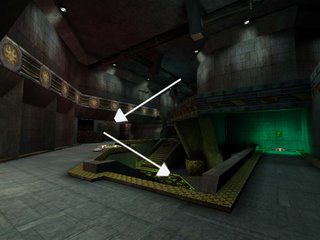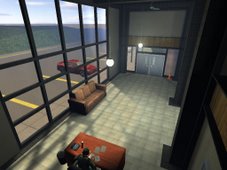THE DEAD END
(primarily MP)
(primarily MP)
Having a dead end in your level can be catastrophic, and should be completely avoided if possible. A dead end is defined as: the sole entry is also the only exit. If a region has 2 entrances and 1 exit, it's not a dead end, but not much better. Sometimes the dead end is unavoidable for many reasons (visibility, unexpected design flaws, etc) but there are some ways to negotiate having a dead end for the good. First thing, is a teleporter. These devices work, but are typically less than smiled upon in the design world unless you are in singleplayer. The second way to make the dead end less deadly, is by making it worth the risk of getting trapped and placing extremely powerful items and power-ups within it. The players going here must be willing to commit possible suicide, but at least they can be rewarded--instead of being frustrated by finding nothing except the chore of running back out of this level bastardization. Even long hallways that take large amounts of time to navigate down can entrap the player in a bad situation, and should never take more than a few seconds to get through. Alcoves are alright if they only take roughly 1 second to get in and 1 second to get out of. Of all things to NOT do in your level...Dead End is king....the murderer of good flow.
NOVELTIES
(MP)
(MP)
Everyone wants their level to be unique, or the wildest ride imaginable. Some designers get the crazy idea to create novelties in their levels. An example of a novelty would be low gravity, or underwater, perhaps rotating platforms..something that generally stands out in a level. Sometimes, these outstanding concepts can be killer, and should be used very carefully. It's in this designers opinion that if you do go with some novelty, that it should only be 1 per level. I still wouldn't recommend maps with that extra edge, because it is no replacement for a well designed map. Novelties can be an extreme hindrance in gameplay and stressful to the player, so take note. On the other hand, singleplayer games revolve around this kind of setup, and usually the more there is, the merrier the gaming experience. Strange how it works, huh? The difference is the pace. Multiplayer games need to be fast and flowing with little time for decision making, its run and gun. Singleplayer typically puts the players at less high-paced duress, and gives them time to think or make those difficult jumps onto moving platforms.
OVER AND UNDER
(MP AND SP)
(MP AND SP)
This is what separates the boys from the men (or girls from the women). While not having over and under in your map won't kill the map, it certainly will make it boring and novice-like. Over and Under (or region over region) gameplay is when you are forced to look up or down at other regions of the map, rather than always looking straight ahead of yourself like many of the earliest shooters did. Over and under creates dynamic gameplay and unleashes new elements of strategy in your level. The flip side to this concept are the technical issues they can cause. Over and under means you are exposing more areas, which can add more expense and a bigger hit to the performance of the level, which is why planning is crucial--to avoid going overboard on your budget. The idea is to limit what is visible (visibility: which we will discuss soon), while keeping interesting gameplay elements in your map. A simple example of over and under is pictured in this tutorial.

THE WAY OUT
(primarily MP)

THE WAY OUT
(primarily MP)
Going back to the Dead End segment of this lesson. In similar fashion, one thing to remember is leaving ways out. Every area (or region) needs at LEAST 2 ways leading out of the area, preferably three. This can actually be the hardest thing for novice designers to pull off, once again, because having so many areas opened up for gameplay, it can cause performance problems. With any luck, proper planning and vis (soon to be discussed) should save you here. Having multiple ways out of an area creates unpredictable playing situations. If a player has only 1 way out of an area, the gameplay becomes predictable, and it is impossible to shake or lose an enemy. With at least 2 exits, you can alter tactics and sneak off in another direction into safety. Over and Under can help out with this tremendously too; instead of heading forwards towards a doorway, players can drop off a ledge or climb a ladder and escape to another reion.
Coming soon, i will discuss some of the importance of budgeting a level. Levels that are fun and visually stunning are only good if they actually run decently on a computer. This is partially where system specs come from.
Coming soon, i will discuss some of the importance of budgeting a level. Levels that are fun and visually stunning are only good if they actually run decently on a computer. This is partially where system specs come from.












No comments:
Post a Comment